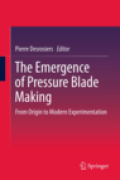
The emergence of pressure blade making: from origin to modern experimentation
Desrosiers, Pierre M.
Human development is a long and steady process that began with stone tool making. Because of this skill, humans were able to adapt to climate changes, discover new territories, and invent new technologies. 'Pressure knapping' is the common term for one method of creating stone tools, where a larger device or blade specifically made for this purpose is use to press out the stone tool. Pressure knapping was invented in different locations and at different points intime, representing the adoption of the Neolithic way of life in the Old world. Recent research on pressure knapping has led for the first time to a global thesis on this technique. The contributors to this seminal work combine research findings on pressure knapping from different cultures around the globe to develope a cohesive theory. This contributions to this volume represents a significant development to research on pressure knapping, as well as the field of lithic studies in general. This work will be an important reference for anyonestudying the Paleolithic, Mesolithic, and Neolithic periods, lithic studies, technologies, and more generally, cultural transmission. First book to provide a comprehesive, synthesized thesis on pressure knapping. Comprehensive research from around the world, through different cultural and historical periods. Updates the current research on pressure knapping, offering new perspectives from experts in the field. INDICE: Part 1: History of Research on Pressure Knapping. Part 2: PressureKnapping in the World. Africa. Europe. Asia and the Arctic World. Mesoamerica. Part 3: Recent Advances in Experimentation.
- ISBN: 978-1-4614-2002-6
- Editorial: Springer New York
- Encuadernacion: Cartoné
- Páginas: 20
- Fecha Publicación: 28/02/2012
- Nº Volúmenes: 1
- Idioma: Inglés
